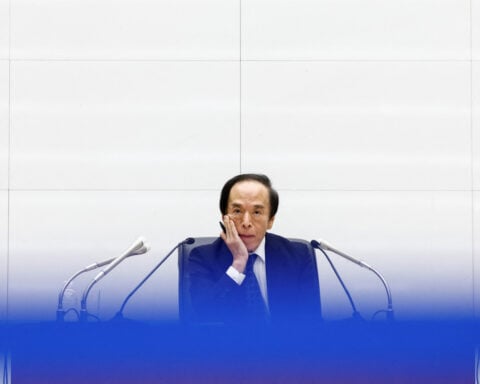By Jamie McGeever
ORLANDO, Florida (Reuters) - Leveraged funds trading U.S. Treasuries futures have increased their record net short position across the curve, which will do little to soothe growing concerns among regulators about the potential financial stability risks these bets pose.
Hedge funds have rapidly built up short positions in U.S. Treasuries futures this year as part of the so-called 'basis trade', a leveraged arbitrage play profiting from price differences between cash bonds and futures.
The Bank for International Settlements has warned that the huge build-up in speculators' Treasuries positions "is a financial vulnerability", and a recent Fed paper said it warrants "diligent monitoring".
The price difference between cash bonds and futures is tiny, but funds make their money from high levels of leverage in the repo market and sheer volume of trade.
Commodity Futures Trading Commission (CFTC) data for the week ending October 17 show that leveraged accounts - those funds and speculators more likely to be active in the basis trade - grew across the two-, five- and 10-year space by 250,000 contracts to a total 4.71 million contracts.
That is significantly larger than the peak combined net short position from 2019 of just over 4 million contracts.
The move was particularly strong at the shorter end of the curve. Leveraged accounts increased net short position in two-year futures by 133,000 contracts to 1.554 million contracts and by 92,000 contracts in the five-year space to 1.753 million.
That's a whisker from the two-year record net short of 1.558 million contracts in 2019, and a fresh record five-year net short.
A short position is essentially a wager an asset's price will fall, and a long position is a bet it will rise. In bonds falling prices indicate higher yields, and vice versa.
But funds play Treasuries futures for other reasons, like relative value trades, and this year, the basis trade.
These trades appear to be a key factor behind the U.S. bond market's steep decline in recent months, but by no means the only one.
Worries over the U.S. government's fiscal health, increased debt issuance from Treasury, the Fed's ongoing 'quantitative tightening' program, stronger-than-expected economic growth and a reassessment of the interest rate outlook have all contributed to the extraordinary bond selloff recently.
Yields across the curve last week hit their highest levels since 2006-07, and on Thursday the entire Treasury curve from one-month to 30-year yield maturities was within half a basis point of being above 5%.
(The opinions expressed here are those of the author, a columnist for Reuters.)
(Writing by Jamie McGeever; Editing by Miral Fahmy)

 Japan's Makino Milling requests changes to unsolicited bid from Nidec
Japan's Makino Milling requests changes to unsolicited bid from Nidec
 South Korea's Yoon likely to be held in a solitary cell
South Korea's Yoon likely to be held in a solitary cell
 Michigan Gov. Gretchen Whitmer, a potential 2028 candidate, wants to find common ground with Trump
Michigan Gov. Gretchen Whitmer, a potential 2028 candidate, wants to find common ground with Trump
 Trump's Greenland bid stirs debate in China about what to do with Taiwan
Trump's Greenland bid stirs debate in China about what to do with Taiwan
 Inflation duo takes centre stage
Inflation duo takes centre stage
 Manatees congregate in warm waters near power plants as US winter storms graze Florida
Manatees congregate in warm waters near power plants as US winter storms graze Florida
 As Los Angeles burns, Hollywood's Oscar season turns into a pledge drive
As Los Angeles burns, Hollywood's Oscar season turns into a pledge drive
 As fires ravage Los Angeles, Tiger Woods isn't sure what will happen with Riviera tournament
As fires ravage Los Angeles, Tiger Woods isn't sure what will happen with Riviera tournament
 Antetokounmpo gets 50th career triple-double as Bucks win 130-115 to end Kings' 7-game win streak
Antetokounmpo gets 50th career triple-double as Bucks win 130-115 to end Kings' 7-game win streak








